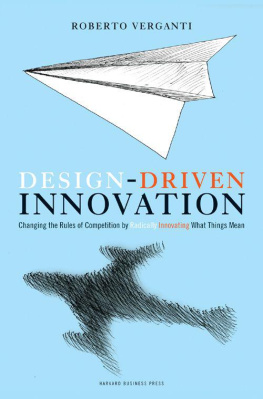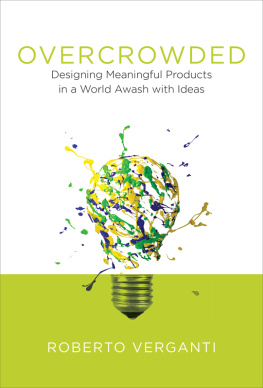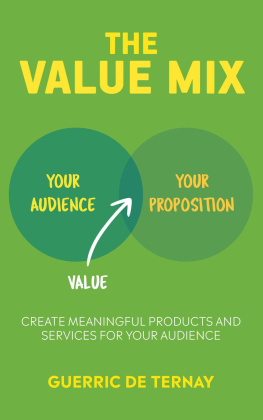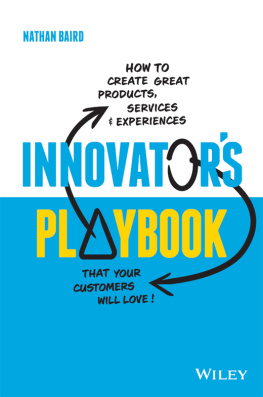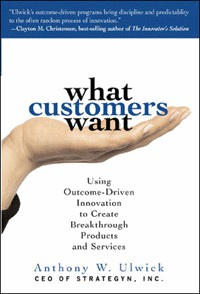Copyright 2009 Harvard Business School Publishing Corporation
All rights reserved
No part of this publication may be reproduced, stored in, or introduced into a retrieval system or transmitted, in any form or by any means (electronic, mechanical, photocopying, recording, or otherwise), without the prior permission of the publisher. Requests for permission should be directed to , or mailed to Permissions, Harvard Business School Publishing, 60 Harvard Way, Boston, Massachusetts 02163.
First eBook Edition: August 2009
ISBN: 978-1-4221-2482-6
The paper used in this publication meets the requirements of the American National Standard for Permanence of Paper for Publications and Documents in Libraries and Archives Z39.48-1992.
To Francesca,
the meaning of my life
[ Contents ]
An introduction
Innovating by making sense of things
Placing design-driven innovation in the strategy of a firm
The interplay between technology-push and design-driven innovation
Why companies do or do not invest in design-driven innovation
Doing research with the design discourse
Finding and attracting key interpreters
Developing your own vision
Leveraging the seductive power of the interpreters
How to start
The key role of top executives and their culture

A marketing manager for Apple described its market research as consisting of Steve looking in the mirror every morning and asking himself what he wanted. That is the mirror of an executives personal culture. Culture is one of the most precious gifts of humanity. Everyone has it. You should be not afraid of that mirror but, rather, leverage it, and see there things that others do not. [IN THE ILLUSTRATION Apples MacBook Air.]
This is not a book on design, at least not in the way many people think of design: it is not about styling, or about creativity, or about scrutinizing users.
This is a book on management. Its about how to manage innovations that customers do not expect but that they eventually love. It shows how executives can realize an innovation strategy that leads to products and services that have a radical new meaning: those that convey a completely new reason for customers to buy them. Their meanings are so distinct from those that dominate the market that they might take people by surprise, but they are so inevitable that they convert people and make them passionate.
This strategy is called design-driven innovation because design, in its etymological essence, means making sense of things. And design-driven innovation is the R&D process for meanings. This book shows how companies can manage this process to radically overturn dominant meanings in an industry before their competitors do and therefore rule the competition.
The framework illustrated in the following chapters comes from ten years of research. There you will find the practical content and the evidence. Here, however, I want to step outside the flow of the argument, just for a moment, and talk more intimately about what I feel my findings imply for you as a person and as an executive (or a designer). This is my personal letter to the reader.
Managers Are People Before Being Managers
A marketing manager for Apple described its market research as consisting of Steve looking in the mirror every morning and asking himself what he wanted. This claim seems preposterous and illogicalalmost blasphemous. It contradicts popular theories of user-centered innovation. We have been bombarded by analysts saying that companies should get a big lens and peruse customers to understand their needs.
The framework provided in this book shows that even if a company does not get close to users, even if it apparently does not look at the market, it can be much more insightful about what people could want. That mirror in which Steve Jobs metaphorically looks at himself is not a magic gizmo that delivers soothsayings: it is the mirror of an executives personal culture. It reflects his own vision about why people do things, about how values, norms, beliefs, and aspirations could evolve, and also about how they should evolve. It is a culture built from years of immersion in social explorations, experiments, and relationships in both private and corporate settings.
Every executive has her own personal culture, her own vision of the evolution of the context of life in which her products and services will be used. Every person relentlessly builds her culture, often implicitly, by simply being immersed in society and through the individual explorations of life. Executives do not need to be experts in cultural anthropology or pretend to be like gurus or evangelists. Culture is one of the most precious gifts of humanity. Everyone has it.
Often, however, this gift remains unharnessed. Management theories do not help us unleash it. Rather, they often suggest that people hide it. The innovation tools, analytical screening models, and codified processes that experts recommend are typically culturally neutral or even culture averse. When innovation is purely technical (such as when it optimizes an existing feature), these methods may work well. However, when a firm wants to radically innovate the meaning of products and propose new reasons why people could buy things, these culturally neutral methods fail miserably.
In this book you will see how companies have transformed breakthrough ideas into acclaimed business successes right after other firms dropped them as uninteresting or outlandish. My question is, Why do some executives recognize the stunning business value of breakthrough proposals better than others? How can you prepare yourself to create and recognize these opportunities?
The answer, in terms of management practice, is in the following chapters. However, a more subtle notion underlies these accounts. Many of the executives you will meet reveal an interesting combination of two personal characteristics: a belief that culture is an essential part of everyday life (and therefore of business) and a significant un-awareness of established management theories.
That is definitely true of, for example, Steve Jobs. But it is also true of the Italian entrepreneurs I discuss. In Italy, primary and secondary education have been sharply focused on the humanities, making culture an essential part of the personality of entrepreneurs. Management sciences, in contrast, have developed much more slowly in Italy than in other countries (almost none of these entrepreneurs has an MBA). These managers somehow did not come in contact with what prevented other executives from leveraging their cultural assets. This does not mean that these leaders did not fulfill their role as executives. Simply, their management practice was completely different from existing theories.
This book shows that you can direct your personal cultureyour treasure, and the treasure of colleagues both inside and outside your firmtoward the creation of economic value. If properly nurtured and shared, this asset can become an integral part of your being a business leader. I hope this book will help you to be unafraid of looking into the mirror to leverage your personal culture, seeing there things that others do not. Not because you are creative. Not because you are a guru. Because you are a businessperson.
Designers Are People Before Being Designers
This is not a book on design. But I hope designers will appreciate it, because it unveils one of the forgotten angles of their contribution to business and society.

